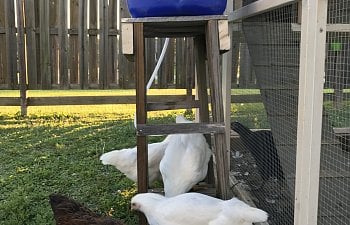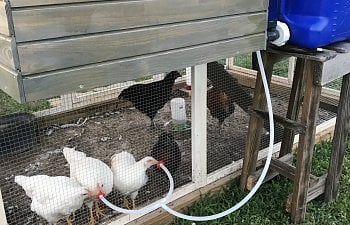
I have scoured and scoured the interwebs for a watering system that suited my needs. Or rather the needs of my chickens! We were looking for something that was spill proof, poop free, would hold a minimum of a weeks's water, AND the BIG one--took up no space in their run. I know, I don't ask for much, right?
The closest I could find was the PVC pipe with nipples. I really didn't want that as I felt I would have to cut into my hardware cloth, at least a little bit, to install it and I figured it would just be something else to poop on.
I did find that a couple of rabbit farmers were using a tubing system with rabbit nipples attached to the mesh with brackets, the tubes running outside to the water source--a rain barrel or 5 gallon bucket. We were getting closer to what I was looking for, but the rabbit nipples (almost identical to the vertical chicken nipples) were less than desirable because I wanted to minimize dripping as much as possible and, for that reason, I wanted horizontal chicken nipples.
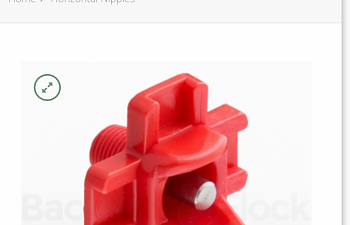
I wondered if I could just swap out the nipples and use the tubing and brackets sold for rabbits. Strangely, but not surprisingly--since the man is always trying to stick it to us--rabbit nipples are a standard 1/4" on the back fitting whereas chicken nipples are 3/8". Such a small difference, but I wanted everything to fit tight to avoid drippage. I saw I was on my own to put this together.
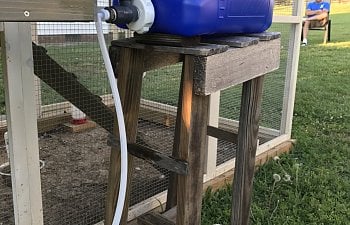
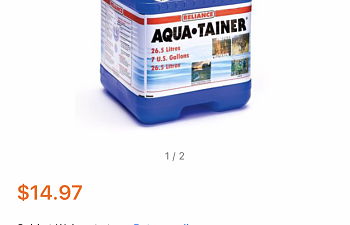
I started with the water container. I looked around Craigslist and such for cheap food grade water barrels and such, but couldn't find anything I trusted. I ended up getting the Aqua-tainer from Wal-Mart for just under $15. It holds 7 gallons, the perfect size for my girls! Bonus, it had a screw on ring collar with removable dispenser spout (like on a lemonade dispenser). I removed the cheap spout and my 3/4" rain barrel spout (Amazon) screwed right in. I then used a metal bushing to step down to the 1/2" I needed for a 90 degree elbow that adapted down to 3/8" to attach my tubing. I ran this down to a barbed "T" and then to 2 horizontal nipples. By placing them against my 1/4" mesh, I screwed the nipples right in. I did pre-wrap the nipple threads in plumber's tape for good measure.
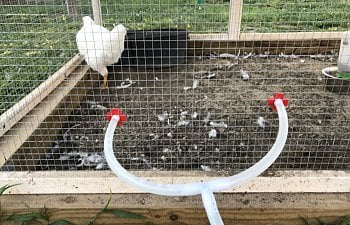
The girls were super excited to see the little red nipples when they came back in the run and started drinking from them immediately. I could have gotten away with 1 nipple, but I did 2 for good measure--after all, waiting in line is for the DMV!
I am test driving it this and the coming week as I am going to be out of town for a week soon and want to give the chicken checker in on (that's a thing, right?) less to do. I will come back and update with the results.
Now to find the perfect feeding setup...
*Update 7/25/17
So, I said I would update after test driving. I was able to try it out for over a week before going on vacation. I left up a standard size rabbit bottle during this time in case of a failure. During that time the only issue I had was when the girls were out and about and one portly lady decided to roost on the tubing while I was inside the coop doing some cleanup. I tried to shew her off from inside, but failed and the tubing ended up slipping off the nipple. I cleaned the nipple and reapplied teflon tape before reattaching it to the nipple. I considered applying a clamp for extra security, but haven't found it necessary yet. I did just return from a 9 day vacation and my chickens were supplied with plentiful, clean water the entire time. My neighbor checked in on them periodically but had no work to do other than giving them some nightly treats. They didn't even touch the water in the rabbit bottle, so I know the nipples are their preference now. I am thrilled to report there is no leaking or dripping! The only changes I would make/might make in the future are 1) to run the tubing against the coop/run structure (held in place with clamps or such) to keep curious chickens off of it and 2) I could add an easy connect valve to the spout for ease in connecting and disconnecting OR more likely, drill a hole and add a bulkhead on the top side of the container to be able to stick the hose in to refill.

